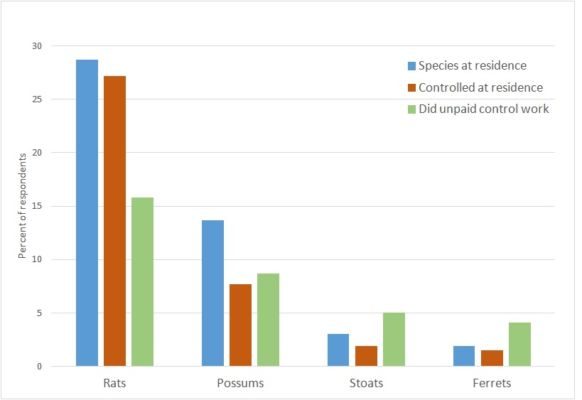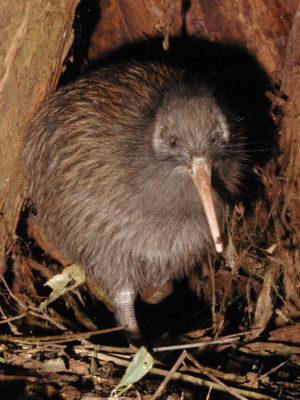Rats are the introduced predator that homeowners are most likely to combat, according to the results just out from the 2016 ‘Public Perceptions of New Zealand’s Environment’ survey, with almost all respondents who had rats present, reporting that they attempted to control the rats near their home. Poison was the most frequently reported method of rat control. By contrast, only 56% of respondents who had possums near their home attempted to control them. Possum traps were the method generally used.
These are just some of the results relating to our attitudes to introduced predators and predator control – a new section of the survey sponsored by Predator Free New Zealand Trust. The predator control section investigates both homeowner predator control and also the extent to which New Zealanders volunteer in predator control projects in the reserves and parks in their wider community.
The ‘Public Perceptions of New Zealand’s Environment’ survey has been carried out regularly since 2000 and is renowned for giving key insights into the attitudes and viewpoints New Zealanders have regarding conservation and the natural environment. The 2016 Survey was the 8th carried out by Lincoln University researchers Ken Hughey, Geoff Kerr and Ross Cullen. Their findings make for very interesting reading.
Firstly, a general overview of findings relating to our perceptions of the quality of the environment in New Zealand:
“New Zealanders continue to consider the state and management of the New Zealand environment to be good, and better than in other developed countries. The states of air, and native bush and forests were rated highest, while rivers and lakes, and marine fisheries were rated as being in the worst state. Management of all components of the environment was considered to be adequate to good, with management of national parks rated the highest. Rivers and lakes, and groundwater were judged to be the worst managed parts of the environment.”
Are our native forests and bush really in such a good state? Does public perception match reality? The value of a survey such as this to conservationists is that, by revealing what public perceptions are, we can assess how well informed members of the general public are and how well we, as conservationists, are communicating the problems and issues that do exist.
It’s a large and comprehensive survey – we’ll skip to the bit that most concerns introduced predators:
“The [PFNZ Trust] case study concerned predator control and priority species for conservation. Rats were much more prevalent near respondents’ homes than were possums, stoats and ferrets. Almost all respondents attempted to control rats near their home, but only 56% of respondents who had possums near their home attempted to control them.”
“Trapping is widely used to control possums, stoats and ferrets, while poisons are most commonly used to control rats. Fifty percent of the respondents thought that the Department of Conservation and/or Regional Councils should be doing much more than their current efforts to control rats, ferrets, stoats and possums.”
Half of respondents want central and local government agencies to do more. That’s a significant proportion of tax-payers and rate-payers.

“Twenty nine percent of respondents reported rats at their residence, and nearly all of them (27% of respondents) attempted to control rats at their residence. A smaller, but highly significant, proportion (16%) did unpaid rat control work. Possums were much less common at people’s residences (14%), and stoats (3%) and ferrets (2%) were rare. Notably, for all three of these species, control efforts were more common away from home than at home. Whereas people with rats, ferrets and stoats at their residence nearly always attempted to control them, only 56% of respondents with possums at home attempted to control them.”
Reasons for carrying out predator control varied too. Some respondents were worried they’d catch diseases from rats invading their home. Others may have been more concerned about damage to their wiring.
“Of the 27% of people who controlled rats at their residence, the strongest motivation (23%) was because rats were a nuisance, although environmental (11%) and human disease (10%) motivations were also prominent. Possums were controlled less frequently (by 14% of respondents), but environmental motivations were more prominent (6%). Stoats and ferrets were similar in that the most prominent control motivator was the environment, followed by nuisance.”
Not surprisingly, control methods varied depending on what predator was being controlled.
“Trapping was the most common method for controlling possums, stoats and ferrets, with shooting a strong secondary approach for possums. Rats were somewhat different, with 16% of the 27% of households that controlled rats using ground-based poison. More than one in nine of the households that controlled rats used cats or dogs to do so.”

Volunteer work was also a major part of the predator control activity carried out by respondents. As the results graph shows, respondents were more likely to control possums, stoats and ferrets through volunteer work in their community, than to control them in their own homes.
A total of 15.8% of respondents controlled rats through community volunteer work, while approximately 8.7% controlled possums, 5% controlled stoats and 4.1% controlled ferrets.
With respect to risks to native species and which species were most in need of protection, the survey revealed that kiwi were of most concern to respondents. They were considered the most at risk and most in need of protection.
“There was a tussle between Hectors/Maui dolphins and Kakapo for second and third places, with
the Kakapo being more frequently perceived to be at risk than the two small dolphins, but not quite as commonly nominated as a priority for protection.”
The full report is available through Lincoln University and can be viewed online at:
Lincoln Research Webpage

